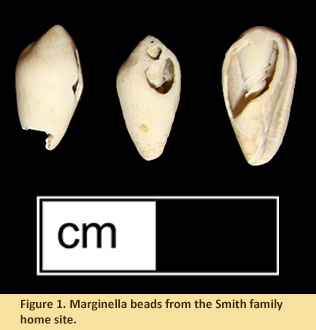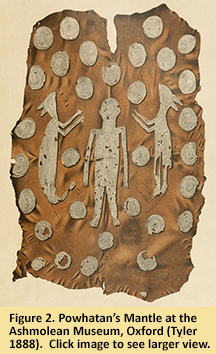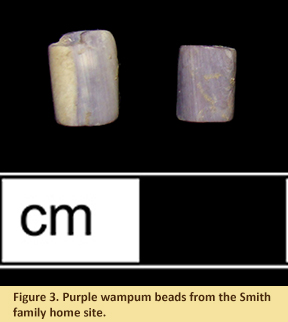Curator's Choice 2017
Not Just Another Marginal Artifact
December 2017
By Ed Chaney, MAC Lab Deputy Director
 In 2016 and 2017, archaeologists at Jefferson Patterson Park and Museum found several marginella shell beads at the 18th-century home of the Smith family (Figure 1). English colonists did not often use shells as jewelry, so why were the beads there?
In 2016 and 2017, archaeologists at Jefferson Patterson Park and Museum found several marginella shell beads at the 18th-century home of the Smith family (Figure 1). English colonists did not often use shells as jewelry, so why were the beads there?
Marginella and related marine snails are found throughout the world. The Common Atlantic Marginella (Prunum apicinum) lives in tidal areas and seagrass beds along Atlantic coast from southern New England to the Gulf of Mexico, and beads made with its shell were popular with Indians of eastern North America (Lowery et al. 2014). Although shell beads of various origins had been in use for several thousand years, Prunum apicinum beads did not become common until after contact with Europeans in the 1500s (Ceci 1986).  According to the early explorer John Lawson (1709), coastal Indians would dip lines baited with oyster pieces into the water, then pull them out when covered with sea snails. The shells would be traded to groups in the interior, as the coastal peoples placed little value on them – a statement supported by archaeological evidence (Curry 1999).
According to the early explorer John Lawson (1709), coastal Indians would dip lines baited with oyster pieces into the water, then pull them out when covered with sea snails. The shells would be traded to groups in the interior, as the coastal peoples placed little value on them – a statement supported by archaeological evidence (Curry 1999).
The manufacture of beads from marginella and other shellfish exploded during the colonial period (Ceci 1986). The holes in thin-shelled marginella beads were usually produced by grinding them on rocks, or gouging them with a tool (Francis 1986). The beads could then be strung together as ornaments, woven into belts, or sewn onto garments. Powhatan’s Mantle (Figure 2), a 17th-century deerskin robe from Virginia, is decorated with thousands of marginella beads (Painter 1990). Most commonly, lengths of shell beads were used as currency in the 17th  century by Indians and European colonists alike. But in 18th-century Southern Maryland the beads would have had little monetary value, as the Native trading partners were mostly gone. So why were they found at Smith family home?
century by Indians and European colonists alike. But in 18th-century Southern Maryland the beads would have had little monetary value, as the Native trading partners were mostly gone. So why were they found at Smith family home?
The answer can be seen in other artifacts recovered at the site. For example, a cluster of purple wampum beads, made from the shell of the quahog clam (Mercenaria mercenaria), was found in another part of the site (Figure 3). Wampum was even more popular than marginella as currency. Colonial-period wampum is distinguished by its small, metal-drilled bore holes, like the ones on the Smith site beads (Ceci 1986). Given that only occasional use of the Smith site area occurred during the prehistoric period, it seems likely that the marginella and wampum beads came from two separate colonial-era objects. These could have been simple strands of beads used as currency by the Smith family in the 17th century, and later discarded when they were no longer valuable. But they could also have been on artifacts collected by the Smiths as "curiosities." Prehistoric stone tools, fossils, and the remains of unusual animals have been found on the site in contexts that indicate they were deliberately collected by someone in the Smith household, and not there naturally (see the December 2009 Curator's Choice). It is likely that the marginella and wampum beads recovered at the Smith home had a similar origin.
| References |
|
| Ceci, Lynn |
| 1986 |
Tracing Wampum’s Origins: Shell Bead Evidence from Archaeological Sites in Western and Coastal New York. In Proceedings of the 1986 Shell Bead Conference. Edited by Charles F. Hayes III and Lynn Ceci. Research Records No. 20. Rochester Museum and Science Center: Rochester, NY. |
|
| Curry, Dennis C. |
| 1999 |
Feast of the Dead: Aboriginal Ossuaries in Maryland. Archeological Society of Maryland: Myersville, MD; Maryland Historical Trust: Crownsville, MD. |
|
| Francis, Peter Jr. |
| 1986 |
The Manufacture of Beads from Shell. In Proceedings of the 1986 Shell Bead Conference. Edited by Charles F. Hayes III and Lynn Ceci. Research Records No. 20. Rochester Museum and Science Center: Rochester, NY. |
|
| Lawson, John |
| 1709 |
(1967) A New Voyage to Carolina. Edited by Hugh Talmage Lefler. University of North Carolina Press: Chapel Hill, NC. |
|
| Lowery, Darrin, Christine France, and Torben Rick |
| 2014 |
Stable Isotope Analysis of Modern and Archaeological Whelk and Marginella Shell in Eastern North America. Paper downloaded at https://www.academia.edu/8606479/Stable_Isotope_Analysis_of_Modern_and_Archaeological
_Whelk_and _Marginella_Shell_in_Eastern_North_America. |
|
| Painter, Floyd |
| 1990 |
Powhatan’s Mantle: A National Treasure? The Chesopiean v.28.1. |
|
| Tylor, Edward B. |
| 1888 |
Notes on Powhatan's Mantle, Preserved in the Ashmolean Museum, Oxford. Internationales Archiv für Ethnographie v. 1. |
|